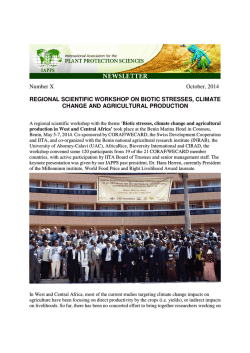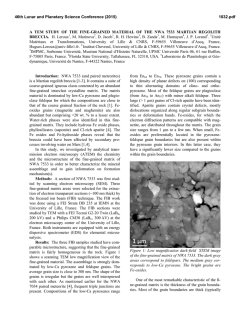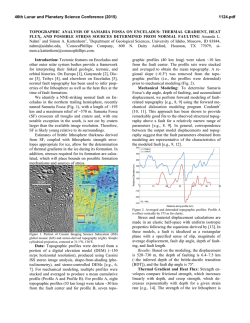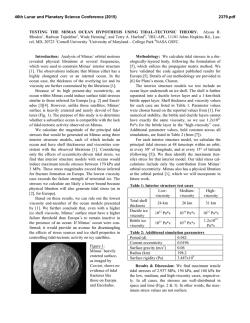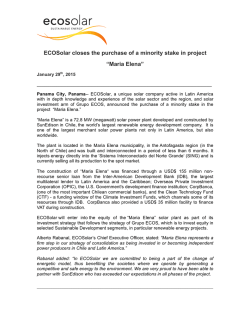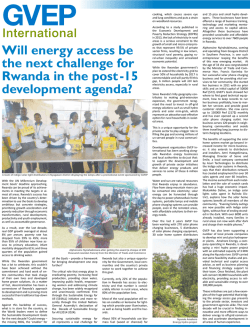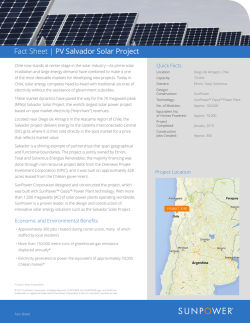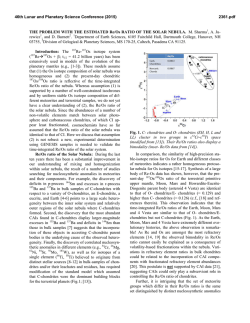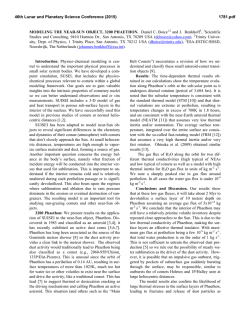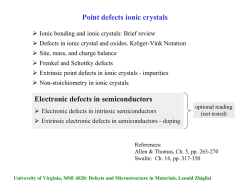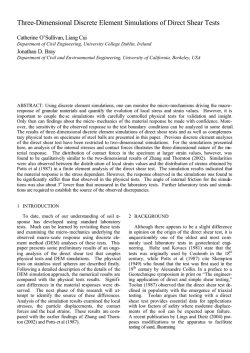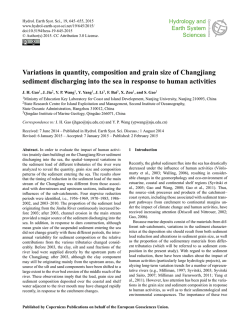
THERMOELASTIC STRESSES ON AIRLESS BODIES
46th Lunar and Planetary Science Conference (2015) 1574.pdf THERMOELASTIC STRESSES ON AIRLESS BODIES: COMPARING MACRO- TO MICROSCOPIC BREAKDOWN PROCESSES. J. L. Molaro1, S. Byrne1, and S. A. Langer2, 1University of Arizona ([email protected]), 2National Institute of Standards and Technology. Introduction: Thermomechanical breakdown of rocks is thought to be an active process in the solar system, especially on airless bodies that experience large diurnal temperature changes and/or have high thermal cycling rates [1, 2]. Researchers have suggested it may operate on (among others) the Moon, Mercury, Mars, Eros, Earth and Phaethon [1-6]. In general, bodies that rotate slowly and/or bodies that have small solar distances have the largest temperature ranges, and thus experience the highest stresses [1], however the extent of the damage produced as a result is unknown. Stresses are being induced in these surfaces at a variety of scales, all of which interact with each other. Propagation of microcracks occurs due to grain scale stresses from expansion/contraction caused by changes in temperature, and mismatches in elastic behavior of adjacent mineral grains [7]. At larger scales, the size and surface curvature [e.g. 8] of, e.g., a boulder will impact how quickly it heats and cools, and to what extent stress is relieved by expansion of the boulder edges. Additionally, temporal and directional heating and cooling of boulders or other topographic features may set up macroscopic temperature gradients that interact with grain scale processes. Here we link surface temperatures to macro- and micro-scale stresses in order to investigate the relationship between thermoelastic processes at these scales, and implications for thermally induced breakdown on airless bodies. Model and Results: In this study, we used a 2-D finite-element modeling program (OOF2) [9] to model the diurnal behavior of microstructures, providing insight into the magnitude and distribution of stresses produced at the grain scale [1]. We imposed solar and conductive fluxes (calculated from a 1D thermal model) on a microstructure over one solar day, and solved the heat and displacement equations. The boundary conditions are defined to simulate a microstructure embedded in an infinite half-space. Thus this model is suitable for investigating the thermoelastic behavior of large rock faces where the effects of size, shape, and surface curvature do not come into play. The microstructures are grids of hexagonal grains (360 µm in diameter) that are assigned properties of plagioclase and pyroxene. We compared the von Mises ( 3J 2 , where J2 is the second invariant of the deviatoric stress tensor) stress induced in homogeneous and heterogeneous microstructures, where the latter is constituted of 75% pyroxene and 25% plagioclase. Results show that heterogeneous lunar surfaces experience a diurnal maximum stress of 150 MPa while under tension (Figure 1). This is comparable to typical rock strengths at larger scales, although grain scale strengths are likely higher. The homogeneous microstructure experiences much lower stresses, indicating that the existence and nature of heterogeneity dominates thermoelastic behavior. Examination of the heterogeneous microstructure during this state of peak tension reveals that maximum stresses are concentrated along surface-parallel boundaries between mineral types (Figure 2), suggesting that temperature and difference in elastic properties between mineral grains determines the magnitude of stresses induced. These stresses can also become apmplified where boundaries are clustered, suggesting that the path of crack propoagation through the microstructure is controlled by grain distribution. Examination of the microstructures over time reveals an anticorrelation between high stresses and large spatiotemporal temperature gradients, indicating that they are not an effective proxy for grain scale stress. Figure 1. Profile of the range of stresses within a microstructure over one solar day for a flat, equatorial Lunar surface. The black line represents a homogeneous pyroxene microstructure and the green envelope a 25% plagioclase and 75% pyroxene mixture. The vertical dotted lines represent the time at which sunrise, noon, and sunset occur, from left to right. 46th Lunar and Planetary Science Conference (2015) Model runs done for arbitrary solar system bodies with varying rotation period and solar distance indicate that bodies that rotate slowly and/or are close to the sun are subjected to the highest stresses. This suggests that certain groups of asteroids, particularly NEAs, may be highly susceptible to thermal breakdown. For example, our model shows that (3200) Phaethon experiences a peak diurnal stress of at least ~300 MPa during perihelion. If the induced stress is high enough to propagate microcracks, its rapid thermal cycling rate may cause breakdown to occur very quickly. This is consistent with the suggestion [6] that thermal processes may be responsible for breakdown of material on Phaethon’s surface and ejection in the Geminid meteor stream. In general, our results [1] indicate that mineral heterogeneity enhances thermally induced stresses in microstructures, and may play the dominant role in the overall efficacy of thermal stress weathering. The thermoelastic behavior and breakdown of rocky materials will be unique to their individual compositions, grain distributions, and locations in the solar system. Additional work is needed to identify in more detail how this process may operate on individual bodies, and quantify breakdown rates. Future Work: Modeling of grain scale thermoelastic behavior on airless bodies provides insight into the amount of stress available to propagate microcracks in these microstructures. However, this model excludes the effects of the shape and size of objects such as boulders. We will address this by utilizing the newly-released OOF3D [10] for a boulder sitting on a flat surface. By thermally forcing the boulder in a similar way as with the 2D model, we will calculate macroscopic stresses and temperature gradients that develop from cyclic temporal and directional heating and cooling. This model will include lateral heat transport, reflected radiation from surrounding topography, and the effects of surface curvature (which creates additional stresses near the surfaces of objects). These macroscopic calculations will provide displacement and heat flux boundary conditions which can then be incorporated into the grain scale model, thus allowing us to investigate the effect of macroscopic stresses and temperature gradients to grain scale behavior. References: [1] Molaro J. L. et al. (2015) in press. [2] Molaro J. L. and Byrne S. (2012) JGR, 117, E10011. [3] Delbo M. et al. (2014) Nature 508, 233– 236 [4] Viles H. et al. (2010) Geoph. Res. Letters, 37, L18201. [5] Dombard A. J. et al. (2010) Icarus, 210, 713-721. [6] Jewitt D. and Li J. (2010) The Astr. Journal, 140, 1519. [7] Kranz R. L. (1983) Tectonophysics, 100, 449–480. [8] Martel S. J. (2006) Geoph. Res. Let- 1574.pdf ters, 33, L01308 [9] Langer et al. (2001) Computing in Sci. & Eng., 3, 15-23 (http://www.ctcms.nist.gov/oof/oof2/). [10] Coffman et al. (2012) Math. & Comp. in Simulation, 82, 29512961 (http://www.ctcms.nist.gov/oof/oof3d/). Figure 2. Stress within the microstructure during the state of peak tension.
© Copyright 2025
